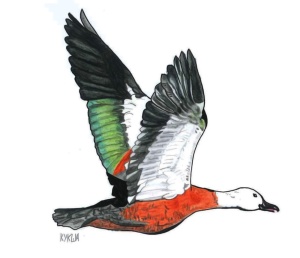Posted by Daria Erastova @Kuukso
My big dream was to study New Zealand native birds. To my utter happiness, I finally joined the friendly Ecology Ngātahi labgroup under the supervision of Margaret Stanley to study ecology of urban native birds. However, I have just started my PhD project and I hope to give you some insights on that later. Instead, I will share some of my experiences birdwatching in New Zealand. Birds of a feather flock together – I found this pastime quite popular in New Zealand, so today I share my top six places to find native birds!
No. 6: Dunedin Botanic Garden, Dunedin.
The famous Dunedin Botanic Garden lies within the city’s green belt and is very big. This, along with numerous old and flowering trees growing there makes this place an excellent haven for birds. Many native species scurry here and there: tui, bellbird, silvereye, fantail etc. There is also an aviary with captive kea, kaka and kakariki.

Silvereye
No. 5: Point England Reserve, Auckland.
This spacious reserve connects with other coastal reserves and is maintained, allowing you to spend a whole day there. This amazing place enables you to get a wildlife experience while staying New Zealand’s largest city. Here you would can find a variety of shore and forest birds. I counted 25 species in a day, including natives like shelduck, kereru and rare little black shag.

Kereru
No. 4. Urupukapuka Island, Bay of Islands.
I was not keen to go there. Urupukapuka proved I was wrong as it turned out to be an outstanding place for birdwatching. In fact, I beat my personal record and identified 27 species in 3 hours! My most interesting encounters were banded rail, New Zealand dotterel, tomtit and North Island robin.

Shelduck
No. 3. Otago Peninsula, Dunedin.
Except for the famous Royal Albatross Colony, where you can also spot Stewart Island shag, and the Penguin Place, with grumpy yellow-eyed penguins, there are other places worth visiting. For example, the Hooper Inlet, inhabited by sacred kingfisher, white-faced heron, grey teal and swamp harrier. The other place is Portobello Bay with royal spoonbill, pied oystercatcher and the cutest little shag. Finally, go to Tomahawk Lagoon for pied stilt or spur-winged plover.

Little shag
No. 2. Tawharanui Regional Park, Auckland.
What is special about this beautiful peninsula is that it is surrounded by a pest-proof fence and has a variety of habitats, including old forests with kaka (you are highly likely to see or hear one), river thickets with spotless crake and seashores with pipits.
No. 1. Tiritiri Matangi, Hauraki Gulf.
This reserve does not need any introduction being one of the most popular tourist attractions in Auckland. After predator eradication and forest replanting the island became the bird paradise. There you all the chances to have a close encounter with species you would never or hardly ever see anywhere else, e.g. little spotted kiwi (one passed 25 cm away from me!), takahe, kokako, brown teal, stitchbird and many more.
I hope this list was useful and enjoyable for all nature lovers. It is based on my limited experience, and there are many other fantastic places, which I am eager to explore. Therefore, if you need a volunteer for your bird fieldwork or a companion on a birdwatching trip, please feel free to contact me.

Kokako
 Daria is a PhD candidate studying the influence of garden sugar feeders on native bird behaviour and health, and whether feeders alter the contribution these birds make to pollinating indigenous plants. She is supervised by Margaret Stanley, Kristal Cain and Josie Galbraith.
Daria is a PhD candidate studying the influence of garden sugar feeders on native bird behaviour and health, and whether feeders alter the contribution these birds make to pollinating indigenous plants. She is supervised by Margaret Stanley, Kristal Cain and Josie Galbraith.


 Carolina Lara M
Carolina Lara M